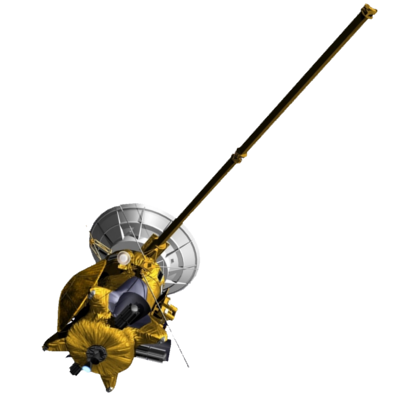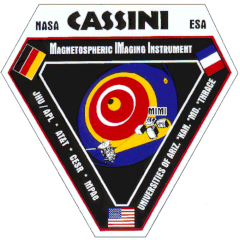Cassini MIMI Investigation at Fundamental Technologies
Historical MIMI Memos and Notes
Telemetry Modes and Allocations
(S. Jaskulek, MIMI team meeting, October 1994)
Mode Definitions
Several operation modes are defined for the MIMI instrument. These modes are used to configure the instrument into predefined power states which are used at the spacecraft systems level to determine the overall power margins. Each power mode defines the power configuration for the MIMI subsystems, including the sensors, electronics, and heaters. The table below shows the configuration of each subsystem vs. the instrument mode. The table is followed by a brief description of each mode.
(Last column not included because of illegibility.)

Notes:
1. A check mark indicates the subsystem is on.
2. An "R" in the EPU or CPU column indicates that processor
board is to be run at a reduced processor clock frequency
(1/16 of its normal rate).
3. A "C," "I," or "L" in the Replacement Heater column
indicates that the CHEMS, INCA, or LEMMS replacement heater
(respectively) is ON. An "A" indicates that all replacement
heaters are ON.
| FULL | This is the normal operating mode for the instrument. All electronic subsystems are active except for the INCA/CHEMS energy and time calibrator. The DPU processor clock is running at full rate (6 MHz). |
| FULL + CAL | This is the same as the FULL mode, except that the INCA/CHEMS energy and time calibrators are active. |
| FULL, Motor OFF | This is the same as the FULL mode, except that the LEMMS motor power is OFF, and the LEMMS supplemental heaters are ON (to keep the motor warm). |
| SLEEP | This mode is defined to allow the MIMI instrument power to be reduced while avoiding power cycling critical subsystems such as the high voltage supplies. This is the normal power configuration for the instrument at Saturn when MIMI science is not enabled due to power restrictions. In the MEU, the CPU board, BIU, LEMMS/BIU interface, and A.E. housekeeping electronics will be fully active, and the EPU will run at reduced clock rate. This electronic configuration allows for control of the LEMMS electronics and the CHEMS and INCA high voltage supplies. It also preserves the software configuration information in both the EPU and CPU, alleviating the need to reload parameters, etc., when the FULL mode is reactivated. The LEMMS sensor electronics will remain on to keep the sensor warm, but the motor will be stationary. |
| IDLE | This mode is the same as the SLEEP mode, except that the LEMMS sensor power and motor supplemental heater are also OFF, and the replacement heater is ON. This allows extended operation of the instrument in a standby configuration without LEMMS operation (should this become necessary). |
| COMATOSE | This mode
is used to cut the MIMI power consumption to a bare
minimum while preserving the software configuration
for FULL operation. It is intended for use during
short duration, high power spacecraft activities.
All sensor power is turned OFF (including HV
supplies), and all analog processing, except for the
housekeeping board, is turned OFF. Both the CPU and
EPU processors will be run at 1/16 of their normal
clock rate to further reduce power consumption. All replacement and supplemental heater power is turned OFF. This lack of any heater power requires that this mode be used for a short period of time only, otherwise the lower flight-allowable temperature limits may be exceeded. |
| MAINTENANCE | This mode is a special version of the POR mode that is intended for use during the cruise period of the mission to exercise the LEMMS motor mechanisms. The electronics will be configured the same as in the POR mode, except that the LEMMS motor power will be ON, and the LEMMS replacement heater will be OFF. (Some power may need to be provided to the LEMMS sensor during this time either through the electronics or the replacement heat....TBD.) The CPU will produce special, smaller, housekeeping packets (~5 bps) in this configuration to fit within the reduced spacecraft telemetry rate. |
| POR | This is the basic mode that is entered when the instrument is first turned on or provided a hard reset command. All subsystems will be OFF except for the CPU, EPU, LEMMS/BIU I/F, and A.E. housekeeping. The instrument will either be running from software stored in PROM or EEPROM; a software program load from the SSR may be necessary before entering the FULL mode. It is expected that all replacement heaters will be ON in this mode, given no electronics heat will be provided from sensor operation. |
| DECONTAMINATION | This mode will be used approximately 1 month after launch for a period of about 30 days. No MIMI electronics will be ON in this mode. The replacement heaters will all be on, and in conjunction with the dedicated decontamination heaters, will keep the sensors from appearing as "cold fingers" for contaminants. |
| OFF | This mode is used when none of the instrument electronics or decontamination heaters is enabled; only the replacement heaters will be on to maintain the subsystems within flight-allowable temperatures. It is expected that this mode will be used for the cruise period (except during motor maintenance activities). |
In all the modes in which the CPU is active, it is expected to maintain control and monitor the activities of the rest of the instrument. To aid in this task, the housekeeping board in the analog electronics will be used to measure and report analog and digital status and parameters. The data will be compared against pre-defined limits to determine if any alarm conditions exist. If such an alarm condition is present, the CPU will take appropriate action as defined by its basic software code, possibly including turning on or off various subsystems and/or signaling an alarm condition via the telemetry stream. The CPU will also appropriately format the housekeeping and status information into housekeeping telemetry packets for transmission to the ground. These activities will continue even when the processor is run at reduced clock frequency.
Return to Telemetry Modes and Allocations main page.
Return to Historical MIMI Notes and Memos main page.
Return to Cassini
MIMI table of contents page.
Return to Fundamental
Technologies Home Page.
Updated 8/8/19, Cameron Crane
QUICK FACTS
Mission Duration: The Cassini-Huygens mission launched on October 15 1997, and ended on September 15 2017.
Destination: Cassini's destination was Saturn and its moons. The destination of the Huygens Probe's was Saturn's moon Titan.
Orbit: Cassini orbited Saturn for 13 years before diving between its rings and colliding with the planet on September 15th, 2017.



